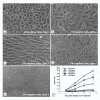Microvascular endothelial cells of the corpus luteum
- PMID: 14613535
- PMCID: PMC305343
- DOI: 10.1186/1477-7827-1-89
Microvascular endothelial cells of the corpus luteum
Abstract
The cyclic nature of the capillary bed in the corpus luteum offers a unique experimental model to examine the life cycle of endothelial cells, involving discrete physiologically regulated steps of angiogenesis, blood vessel maturation and blood vessel regression. The granulosa cells and theca cells of the developing antral follicle and the steroidogenic cells of the corpus luteum produce and respond to angiogenic factors and vasoactive peptides. Following ovulation the neovascularization during the early stages of corpus luteum development has been compared to the rapid angiogenesis observed during tumor formation. On the other end of the spectrum, the microvascular endothelial cells are the first cells to undergo apoptosis at the onset of corpus luteum regression. Important insights on the morphology and function of luteal endothelial cells have been gained from a combination of in vitro and in vivo studies on endothelial cells. Endothelial cells communicate with cells comprising the functional unit of the corpus luteum, i.e., other vascular cells, steroidogenic cells, and immune cells. This review is designed to provide an overview of the types of endothelial cells present in the corpus luteum and their involvement in corpus luteum development and regression. Available evidence indicates that microvascular endothelial cells of the corpus luteum are not alike, and may differ during the process of angiogenesis and angioregression. The contributions of vasoactive peptides generated by the luteal endothelin-1 and the renin-angiotensin systems are discussed in context with the function of endothelial cells during corpus luteum formation and regression. The ability of two cytokines, tumor necrosis factor alpha and interferon gamma, are evaluated as paracrine mediators of endothelial cell function during angioregression. Finally, chemokines are discussed as a vital endothelial cell secretory products that contribute to the recruitment of eosinophils and macrophages. The review highlights areas for future investigation of ovarian microvascular endothelial cells. The potential clinical applications of research directed on corpus luteum endothelial cells are intriguing considering reproductive processes in which vascular dysfunctions may play a role such as ovarian failure, polycystic ovary syndrome (PCOS), and ovarian hyperstimulation syndrome (OHSS).
Figures



Similar articles
-
Angiogenesis in developing follicle and corpus luteum.Reprod Domest Anim. 2004 Aug;39(4):206-16. doi: 10.1111/j.1439-0531.2004.00505.x. Reprod Domest Anim. 2004. PMID: 15225273 Review.
-
Mechanisms of angioregression of the corpus luteum.Front Physiol. 2023 Sep 28;14:1254943. doi: 10.3389/fphys.2023.1254943. eCollection 2023. Front Physiol. 2023. PMID: 37841308 Free PMC article. Review.
-
Administration of a gonadotropin-releasing hormone agonist affects corpus luteum vascular stability and development and induces luteal apoptosis in a rat model of ovarian hyperstimulation syndrome.Mol Cell Endocrinol. 2011 Mar 30;335(2):116-25. doi: 10.1016/j.mce.2011.01.002. Epub 2011 Jan 14. Mol Cell Endocrinol. 2011. PMID: 21238536
-
Angiogenesis in the corpus luteum.Endocrine. 2000 Feb;12(1):1-9. doi: 10.1385/ENDO:12:1:1. Endocrine. 2000. PMID: 10855683 Review.
-
Mechanisms associated with corpus luteum development.J Anim Sci. 1994 Jul;72(7):1857-72. doi: 10.2527/1994.7271857x. J Anim Sci. 1994. PMID: 7928766 Review.
Cited by
-
The diversity of endothelial cells: a challenge for therapeutic angiogenesis.Genome Biol. 2004;5(2):207. doi: 10.1186/gb-2004-5-2-207. Epub 2004 Jan 29. Genome Biol. 2004. PMID: 14759250 Free PMC article. Review.
-
TGFB1 disrupts the angiogenic potential of microvascular endothelial cells of the corpus luteum.J Cell Sci. 2011 Jul 15;124(Pt 14):2501-10. doi: 10.1242/jcs.084558. Epub 2011 Jun 21. J Cell Sci. 2011. PMID: 21693577 Free PMC article.
-
Significance of ovarian macrophages in the follicular aspirates from ART patients.J Assist Reprod Genet. 2007 Apr;24(4):137-42. doi: 10.1007/s10815-006-9102-9. Epub 2007 Feb 16. J Assist Reprod Genet. 2007. PMID: 17450434 Free PMC article.
-
Formation of composite endothelial cell-mesenchymal stem cell islets: a novel approach to promote islet revascularization.Diabetes. 2008 Sep;57(9):2393-401. doi: 10.2337/db07-0981. Epub 2008 Jun 2. Diabetes. 2008. PMID: 18519803 Free PMC article.
-
Yes-associated protein 1 is required for proliferation and function of bovine granulosa cells in vitro†.Biol Reprod. 2019 Nov 21;101(5):1001-1017. doi: 10.1093/biolre/ioz139. Biol Reprod. 2019. PMID: 31350850 Free PMC article.
References
-
- Bruce NW, Moor RM. Capillary blood flow to ovarian follicles, stroma and corpora lutea of anaesthetized sheep. J Reprod Fertil. 1976;46:299–304. - PubMed
-
- O'Shea JD, Rodgers RJ, D'Occhio MJ. Cellular composition of the cyclic corpus luteum of the cow. J Reprod Fertil. 1989;85:483–487. - PubMed
-
- Tamura H, Greenwald GS. Angiogenesis and its hormonal control in the corpus luteum of the pregnant rat. Biol Reprod. 1987;36:1149–1154. - PubMed
-
- Meyer GT, Bruce NW. Quantitative cell changes and vascularisation in the early corpus luteum of the pregnant rat. Anat Rec. 1980;197:369–374. - PubMed
Publication types
MeSH terms
Substances
Grants and funding
LinkOut - more resources
Full Text Sources

